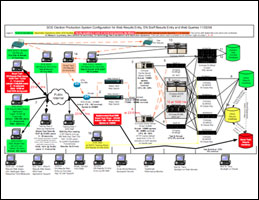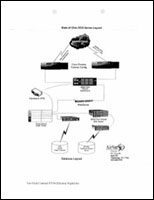By Bob Fitrakis
August 10, 2011
Ohio Secretary of State John Husted has banned all minor political parties in Ohio from the ballot. In an August 5, 2011 letter written to the Libertarian Party of Ohio, Husted made it clear that his interpretation of the draconian Ohio House Bill 194, passed by the Republican-dominated legislature, means that all minor parties have lost their official statewide party status effective September 30, 2011.
In a bizarre twist, Husted wrote that the bill “…included laws related to the requirements minor parties will have to satisfy in order to gain ballot access.”
In Husted’s reading of HB 194, the Libertarian, Green, Socialist and Constitution Parties that have been on the ballot since the 2008 election will have to start over to gain ballot access that they already held under a federal court ruling. In a similar situation, then-Secretary of State Ted Brown left minor parties on the ballot in 1970 and 1972 rather than revoking their ballot access due to a new election law.
In 2006, the 6th Circuit Court of Appeals found the qualifications for minor parties two restrictive and the Ohio election law was declared unconstitutional. One provision in the bill struck down by the 6th Circuit held that minor parties had to file in November of the year before the election. HB 194 moved this petition filing deadline to early February of the election year for minor parties.
But the U.S. Supreme Court in Williams vs. Rhodes, a 1968 Ohio case, ruled that a February deadline is “unreasonably early.”
The law gives the minor parties three and a half months to collect 40,000 valid signatures to place their Party back on the ballot.
The Libertarian Party of Ohio filed a lawsuit on August 9 for “First Amendment rights and voting freedom,” seeking to overturn the short turnaround for the ballot access signatures portion of HB 194.
Former Ohio Secretary of State Jennifer Brunner spoke on Talktainment radio August 10 and was critical of Husted’s letter, arguing that it was a waste of taxpayers’ money to force the minor parties to sue to gain ballot access. “It’s an unfortunate waste of taxpayer dollars. The minor parties should prevail. But the Secretary of State’s office will have to pay the bills out of their budget,” she said.
Brunner and her CouragePAC are part of a broad coalition of forces that include Rev. Jesse Jackson’s Rainbow PUSH and ProgressOhio. They will be gathering signatures to repeal HB 194 because it restricts the right to vote for many Ohio voters, including the elderly, students, urban and poor people. The law forbids pollworkers from directing voters to the correct precinct among other anti-democratic measures.
On August 6 at the Mt. Hermon Baptist Church in Columbus, the anniversary of the historic Selma to Montgomery civil rights march, Rev. Jackson told Ohio activists seeking to repeal HB 194 that “Fundamental to protecting all the rights is voting rights.”
Jackson accused the Ohio Republican Party of embracing a “state’s rights ideology” left over from the Civil War. He stressed that it was no accident that the Republican Party is now engaging in the largest disenfranchising of voters since the Voting Rights Act of 1965, and it is happening in 34 states across the country.
If Brunner and Jackson’s coalition is successful in gathering the signatures to place the repeal of HB 194 on Ohio’s ballot in 2012, the law will not go into effect on September 30. Rather, it will decided by voters in the 2012 November election.
Where this leaves Ohio’s minor parties may ultimately decided by the courts. Part of HB 194 retrospectively “declared void the 2009 and 2011 Secretary of State directives providing ballot access to certain minor parties,” Husted wrote to the Libertarian Party of Ohio. Those directives came as part of a consent agreement between the Secretary of State’s office and minor parties, enforced by Ohio’s federal court in the Southern District.
Husted’s letter makes it clear that he intends to enforce the partisan Republican law even if it is placed on hold by a repeal process.
It was the Libertarian and Green Parties in 2004 that demanded the recount of Ohio’s suspect presidential vote, and it was the Green Party that conducted statewide election protection operations in 2008.
If the Republicans have their way, they will not only remove the minor parties from the ballot, but also the vehicle by which election protection activists observed and reported on Ohio’s presidential elections.
———————————————–
Bob Fitrakis is Co-Chair of the Ohio Green Party and was the attorney who filed to secure the Green Party of Ohio’s ballot access in 2008. He was also an independent candidate for governor in Ohio endorsed by the Greens in 2006.



